Tips for trips, attractions and entertainment
Svorošice stretches from granite to the southwest valley of the Svorošická stream and along the road, from which at the bottom of the village turn the connectors to the West to Petrovice and south to Nýznerov. The cadastre of the village also includes a local part of Petrovice. The permanent residence has 720 inhabitants in the village.
Location in the foothills of the Rychlebské Mountains and Jeseník, suitable especially for hiking or biking.
Above the village is one of the peaks of the Rychlebské Mountains - Špičák - part of the ridge route through the Rychlebské Mountains and the adjoining Jeseníky Mountains.
The giant chair on Sedmilánský vrch is an accessible destination for families with children.
Skorošice includes the "Nýznerovské waterfalls on Stříbrný potok" and the local Museum.
In the village you can use a grass football field or a bike path (behind the church) suitable for inline skating, which is also lined with a fit trail.
In Žulová it is wonderful to get out or ride a bike to Chrámový vrch - "Boží hora" with a church and views of the countryside (also lined with a fit trail).
In the vicinity (6km) in the village of Černá Voda there are bicycle routes "Rychlebské stezky" even for demanding. Here you can also visit the ruins of Kaltenštejn Castle or the natural formation of Venus's Bowl and the Centennial Oak.
Towards Javorník there is the Jánský vrch chateau (in summer a fairytale trail in the gardens free of charge), the ruins of the Rychleby castle, the Devil's pulpit, Račí údolí with a beautiful restored Tančírna, the Borůvková hora lookout tower, the forest bar in Zálesí ...
Towards Jeseník you have to visit the climatic spa in Jeseník - "Priessnitz Spa" (outdoor trail for children, labyrinth ...), the lookout tower Zlatý Chlum + Čertovi kameny.
Other attractions in the area include: Na Pomezí Cave, Na Špičáku Cave, Forest Bar in Lipová lázně, Schrot's health spa, Ramzová - Šerák cable car,, open-air mining museum in Zlaté Hory + Marie Hilfs pilgrimage site (Stations of the Cross), Rejvíz - Mossy lake, spa Karlova studánka, water reservoir Dlouhé stráně - cable car Kouty nad Desnou (Rysí stezka), Praděd, Adrenalin Park Jeseníky na Orlím ranči, Faunapark in Horní Lipová, Dolní Morava (trail in the clouds + mammoth water park), indoor sports and entertainment center Bělá v movement in Bělá pod Pradědem ....
Ski resorts: Miroslav - Lipová Lázně, Lázeňský vrch - Jeseník lázně, Jeseník - Na Smrťáku, Kovárna - Horní Lipová, Filipovice, Ramzová - Bonera, Ramzová - Skiaréna R3, Ski club Ramzová pod Klínem, Zetocha Petříkov, Petříkov - Kaste + Relax, Jonas park Ostružná, SKI Ostružná - Řetězárna, Na Hájovně Branná, Kouty nad Desnou and the highest mountain of Jeseník Praděd with a ski resort where skiing is the longest year of the year.
Swimming possibilities: quarries - Ramp Černá Voda, Transgranit Žulová, Vaněk, Vycpálek, Archbishop's, Brankopy, Pelnář, Gorges, Štachlovice, Kaolinka ...; indoor pools - Priessnitz Jeseník, Javorník, Česká Ves, Helios - Horní Lipová; swimming pool - Jeseník, Červenka Javorník, Velká Kraš
Attractions Poland - Zloty Stock - kopalnia zlota + the longest rope park, Wroclaw - aquapark, laser guns, zoo, Bardo - rafts… ..
Cycling routes
- Cyklotrasa Bílá Voda - Račí údolí - Žulová, Cyklotrasa
- Trasa Žulová - Nýznerov - Petříkov - Ramzová, Turistická trasa
- 3.00 km Cyklotrasa č. 6169 Skorošice - Petrovice, Cyklotrasa
- 16.50 km Turistická trasa Žulová - Nýznerovské Vodopády - Skorošice, Turistická trasa
- 18.00 km Cyklotrasa č. 6043 Bílý potok - Žulová, Cyklotrasa - úsek
We recommend visiting

Granite is a small town with 1300 inhabitants. It is located on the main route leading from Jeseník to Poland. The Granite themselves is the Church of Sts. Joseph. His attraction is the fact that he was built on the site of the former Frydberk Castle, from which only the cylindrical tower, which was incorporated into the church itself. Not far from the church there is Josef Square with a plague column. Here we can also find a stone museum. The surroundings of Granite offer a large number of interesting tourist destinations. An unmistakable dominant is certainly God's mountain that turns off to the height of 527 m.n.m. Here we find a pilgrimage church. There is also a nice view towards Javornik. A blue tourist sign is leading to the top, which lines the cross road. To view God's mountain from afar, there is an adjacent peak pine that is a national natural monument.
 Remains of a medieval castle, of which only a massive cylindrical tower has been preserved, used today as a church bell tower. Built before 1290. Damaged by several Swedish invasions during the Thirty Years' War, uninhabitable in 1642.
The castle was built before 1290 against the will of the bishop by Jan Wustehub, who made raids from there. Other Haugwitz owners continued in the years 1325–58, until Bishop Přeclav of Pogarel bought the castle. The fortress became the seat of the bishop's burgrave and the town in the castle grounds developed. In the 16th century, the castle was rebuilt in the Renaissance style by Bishop Martin Gerstmann. Plundered and burned by the Swedes during the Thirty Years' War. In 1650, residential buildings and chapels were restored, and from 1703 it was used as a brewery. However, it was later demolished and in 1810 a classicist church was built here.
Remains of a medieval castle, of which only a massive cylindrical tower has been preserved, used today as a church bell tower. Built before 1290. Damaged by several Swedish invasions during the Thirty Years' War, uninhabitable in 1642.
The castle was built before 1290 against the will of the bishop by Jan Wustehub, who made raids from there. Other Haugwitz owners continued in the years 1325–58, until Bishop Přeclav of Pogarel bought the castle. The fortress became the seat of the bishop's burgrave and the town in the castle grounds developed. In the 16th century, the castle was rebuilt in the Renaissance style by Bishop Martin Gerstmann. Plundered and burned by the Swedes during the Thirty Years' War. In 1650, residential buildings and chapels were restored, and from 1703 it was used as a brewery. However, it was later demolished and in 1810 a classicist church was built here. More than a dozen quarries invite you to walk, fish or swim at your own risk. At Vápenná you will find the quarries of Archbishop, Barčák, Žulový vrch and Vycpálek; at Žulové lomy Vaněk, Starost and Ferstr; u Černé Vody quarry Ramp and gorge quarry; near Vidnava, quarries Kaolinka and Stachlovice or quarry Pelnář near Uhelná.
More than a dozen quarries invite you to walk, fish or swim at your own risk. At Vápenná you will find the quarries of Archbishop, Barčák, Žulový vrch and Vycpálek; at Žulové lomy Vaněk, Starost and Ferstr; u Černé Vody quarry Ramp and gorge quarry; near Vidnava, quarries Kaolinka and Stachlovice or quarry Pelnář near Uhelná. Nýznerovské waterfalls are located in the settlement Nýznerov u Žulové in the valley of Stříbrný potok. It is a canyon-like gorge with rock thresholds creating several waterfalls and cascades, where pits and giant pots of various shapes up to several meters in size are created due to the eruption of the rock by a whirling stream of water.
The waterfalls form a system of cascades and rapids in a romantic gorge above the mouth of the Bučínský stream. They were formed on a threshold formed by a more resistant rock - the vein of amphibolic gabbro. Due to the relatively high flow, the Nýznerovské waterfalls are an extremely impressive natural phenomenon.
The lower part of the waterfall flows through a narrow rock gorge, which is difficult to access. The upper part is accessible by a staircase, which can be used to get to the bottom of a "boiler". The waterfalls were created at the point where the water hits the rocky thresholds formed by erosion-resistant rock. The water here falls to a depth of 14 m in individual stages and the highest stages reach 3 m.
Since 1968, the Protected Natural Creation of the Stříbrný potok Waterfalls has been declared here. The easiest access is along the forest road from Nýznerov, which is accessible only for pedestrians.
Nýznerovské waterfalls are located in the settlement Nýznerov u Žulové in the valley of Stříbrný potok. It is a canyon-like gorge with rock thresholds creating several waterfalls and cascades, where pits and giant pots of various shapes up to several meters in size are created due to the eruption of the rock by a whirling stream of water.
The waterfalls form a system of cascades and rapids in a romantic gorge above the mouth of the Bučínský stream. They were formed on a threshold formed by a more resistant rock - the vein of amphibolic gabbro. Due to the relatively high flow, the Nýznerovské waterfalls are an extremely impressive natural phenomenon.
The lower part of the waterfall flows through a narrow rock gorge, which is difficult to access. The upper part is accessible by a staircase, which can be used to get to the bottom of a "boiler". The waterfalls were created at the point where the water hits the rocky thresholds formed by erosion-resistant rock. The water here falls to a depth of 14 m in individual stages and the highest stages reach 3 m.
Since 1968, the Protected Natural Creation of the Stříbrný potok Waterfalls has been declared here. The easiest access is along the forest road from Nýznerov, which is accessible only for pedestrians.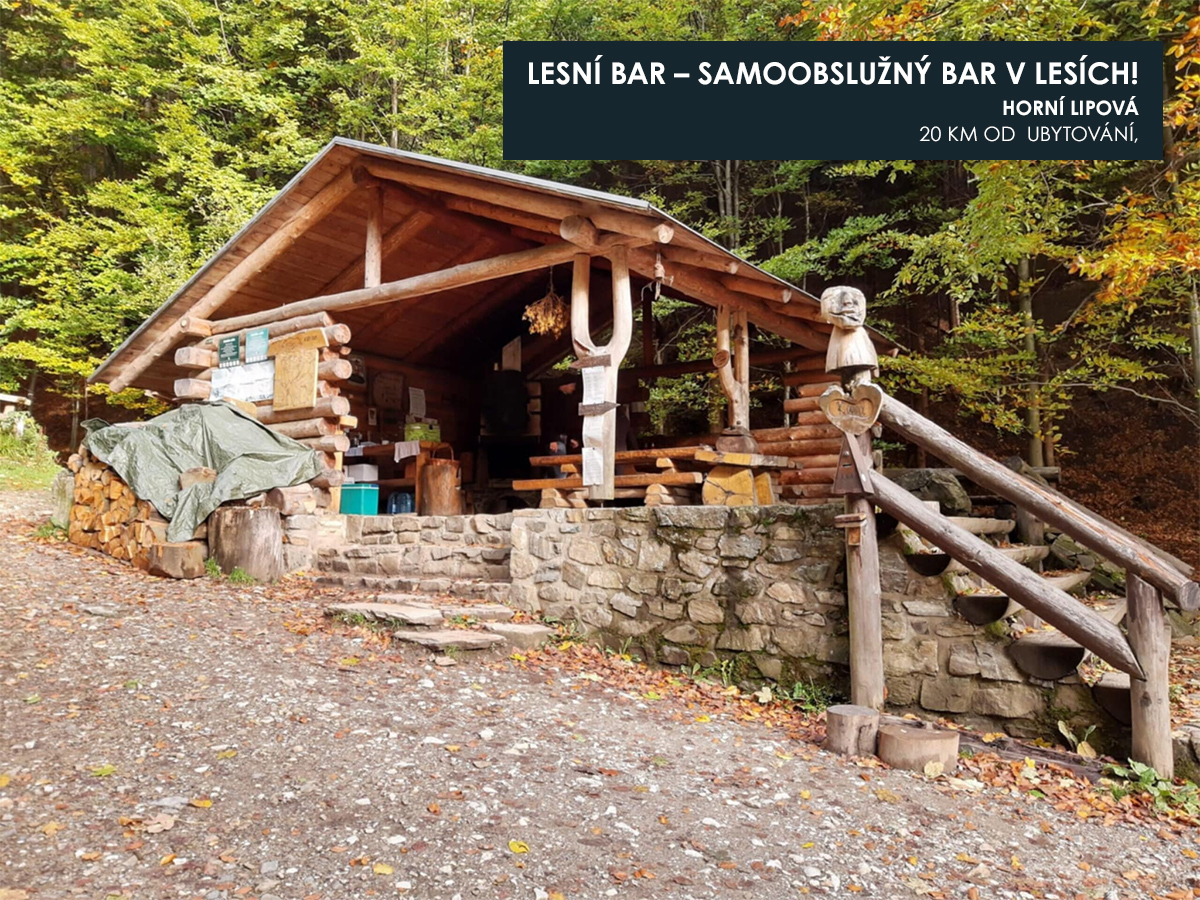
The Forest Bar in the village of Lipová
The Forest Bar is a self-service bar located in Lipová-lázně, in the Horní Lipová area. Follow the hiking trail from Horní Lipová towards Smrk Peak (a border mountain, 1,125 m above sea level), and after approximately 2 km, you will reach our Forest Bar!
It serves as a resting spot for cyclists and hikers, helping to make challenging uphill journeys more enjoyable with stylish rest areas and shelters.
The main Forest Bar is equipped with plenty of seating, a fire pit, and special troughs where you can refresh yourself with spring water or beverages available on-site. You can also prepare coffee or tea, and there are small snacks for refreshment.
A regional specialty, the famous Staroměstské trubičky, made in the nearby village of Branná, is also available. However, due to their freshness, they may not always be in stock—especially in the off-season. We always strive to have them available on weekends, holidays, and other special occasions.
Take a trip to the Upper Bar (800 m away for pedestrians and 4.5 km for cyclists from the Forest Bar) and enjoy a special "mountain shower" along with breathtaking panoramic views of Ramzová, Obří skály, Šerák, and Keprník.
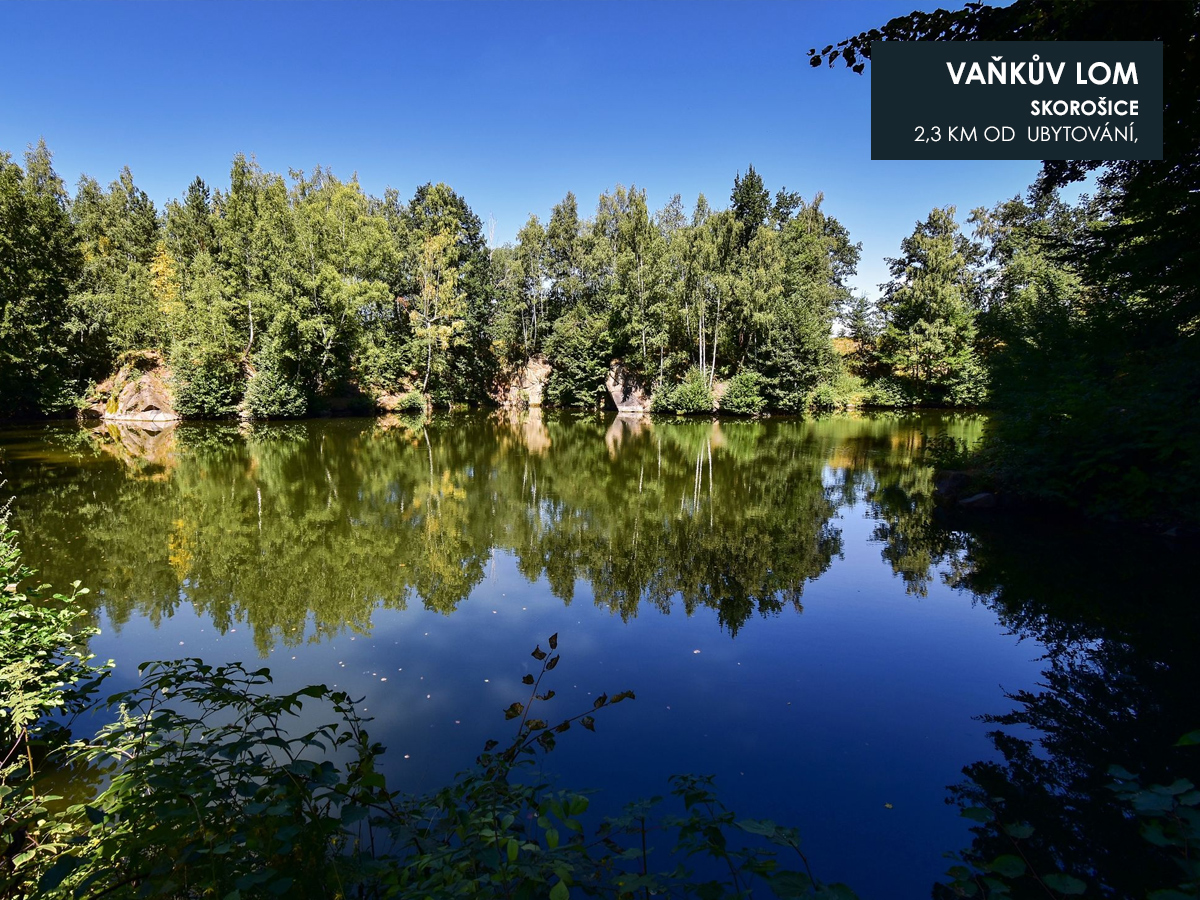
Žulovský quarry is a popular and charming swimming spot, especially favored by the locals. The beaches are grassy."
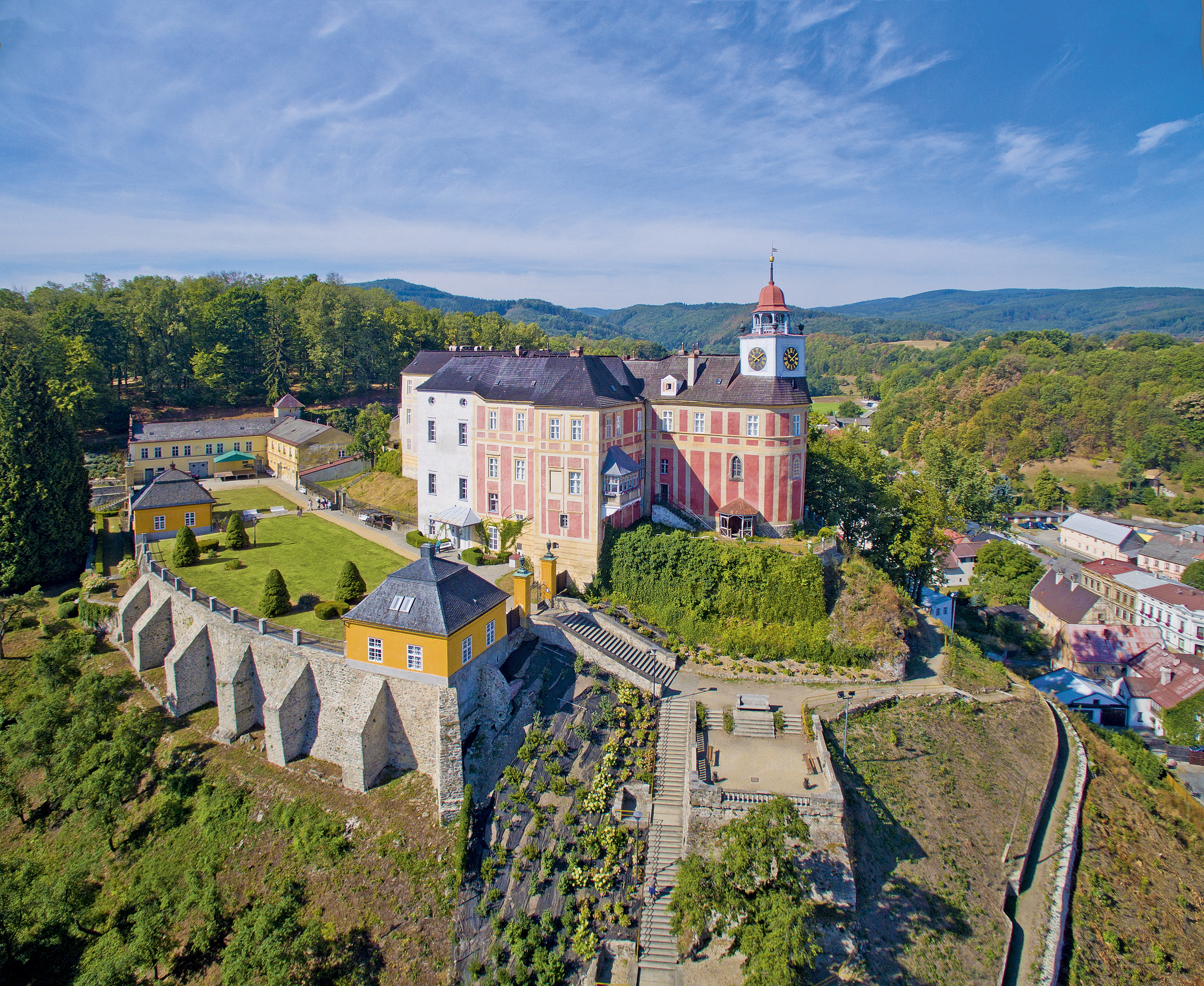
The Jánský Vrch Castle rises on a rocky hill above the town and forms a natural landmark of Javorník and the entire plain surrounding the Polish towns of Paczków, Otmuchów, and Nysa. The history of the castle is linked to the Diocese of Wrocław in Poland, which owned the property and the entire Jeseníky region since 1348. The tour routes will guide you through the representative rooms, which feature an exhibition of a pipe collection, one of the largest in the Czech Republic, as well as the castle's economic facilities. A technical and artistic rarity is the unique preserved gas lighting in the interiors and the main courtyard of the castle. The collection of household textiles in the castle is also valuable, particularly the original curtains, 180 to 200 years old.
.jpg)
One of the most remarkable locations documenting the mesoforms and microforms of granite weathering in the Bohemian Massif is located near the village of Žulová, not far from Jeseník. The unusual natural formations here are the result of long-term and spontaneous granite decay that has been ongoing for tens of millions of years.
Borový Hill is made up of biotic granodiorite and light Silesian granite. It is a system of low rocks and outcrops. As early as the Tertiary period, a solid granite base developed on the island hill of Borový. However, tens of millions of years have passed, and even such a solid rock as granite began to gradually succumb to natural forces over time.
Wind, rain, sun, and frost have created fantastic rock formations, both small and massive. Here, you can find rock overhangs, niches, seats, giant bowls, clints, and pocket-like cavities known as tafoni.
The site is accessible via the blue tourist trail from the village of Žulová.
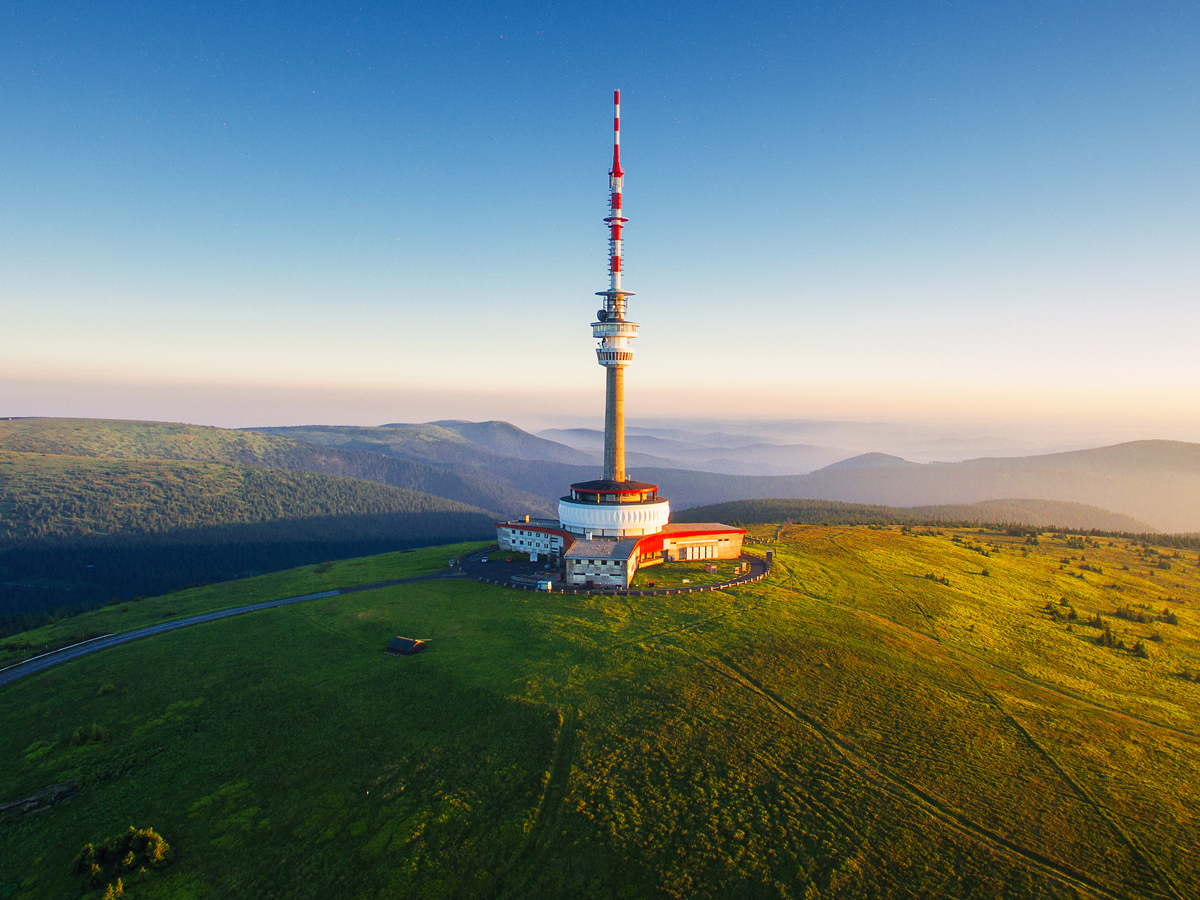
The highest mountain in Moravia and the highest peak of both the Hrubý and Nízký Jeseník mountain ranges is Praděd (1,492 m). At its summit stands a television transmitter with a restaurant and an observation tower. The upper platform of the transmitter is the highest (though artificial) point in the Czech Republic.
Praděd has the harshest climate, with an average annual temperature not exceeding 1°C. On the northern slope of the peak lies the extensive frost cliff of Tabulové skály, home to unique flora. The observation tower is located on the second, higher glass-enclosed platform of the Praděd television transmitter at a height of 73 m from the base of the tower and is accessible by elevator.
From the viewpoint at 73 m, there is a stunning view of Lysá hora, Sněžka, and Radhošť in good weather. In excellent visibility conditions, the High Tatras and Malá Fatra in Slovakia, as well as the Low Alps in Austria, can be seen. Visitors can reach the summit via hiking trails or cycling routes.
Originally, a stone observation tower stood at the summit, built between 1903 and 1912 by the Moravian-Silesian Sudeten Mountain and Tourist Association. The tower was constructed in a romantic style, resembling an old Gothic castle. After World War II, it fell into disrepair and eventually collapsed. With the rise of television broadcasting, a wooden structure with a transmitter was erected on the summit. In 1968, construction of a 162-meter-high transmitter began, and the building was completed in 1983 with the opening of a restaurant.
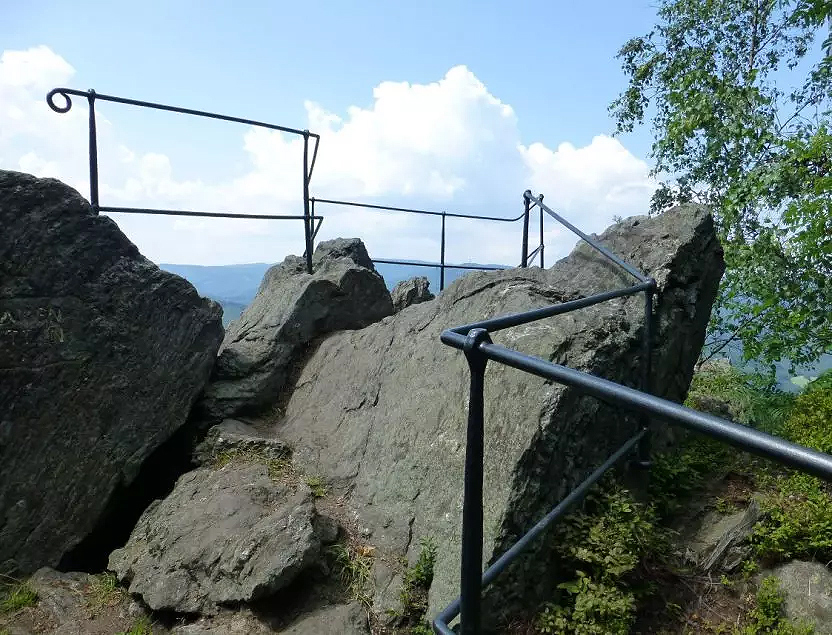
North of the Jeseník Spa, in the area of Studniční Mountain, is a group of rocks known as Medvědí kámen (Bear's Stone). The rocks here have been fitted with an iron railing, creating a lovely viewpoint.
The viewpoint, at an altitude of 907 meters, offers stunning views of the main ridge of the Rychlebské Mountains, the surrounding area of Žulová and Vápenná, as well as the Hrubý Jeseník mountains with the Šerák peak. If that isn't enough, about 200 meters lower, you can find another viewpoint, Thyll's Viewpoint.
There is a green-marked hiking trail leading to Medvědí kámen from Jeseník Spa to the Na Pomezí caves. The path goes past historical spa springs and is about 4 kilometers long. It is also possible to get there from the Lipová stop, following the yellow spa circuit and then the blue trail, though it is quite a steep climb. Trains run to both Lipová Lázně and Jeseník, so those without their own transportation can still enjoy the beautiful views.
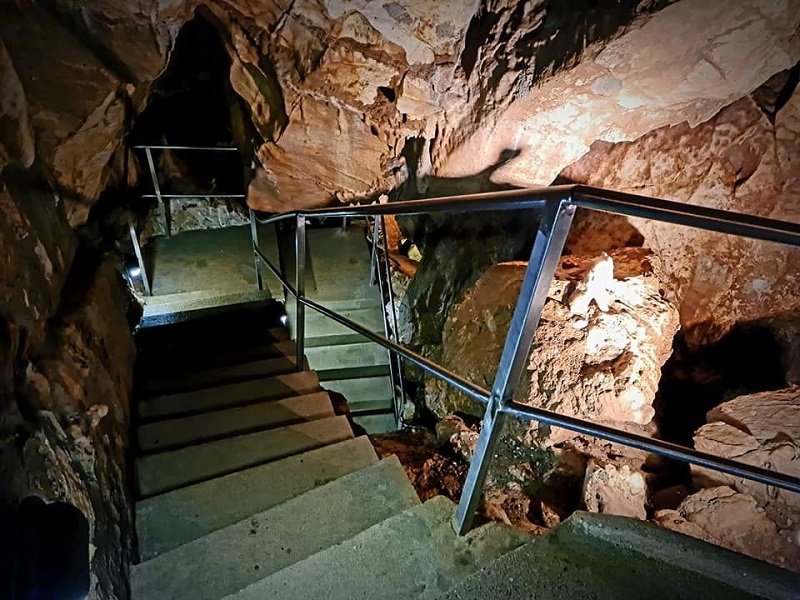
The Na Pomezí Caves are located in the significant communications saddle of the same name (576 m) in the Rychlebské Mountains, 2 km north of Lipová-Lázně. They are the largest cave system in the Czech Republic formed by the dissolution of marble, i.e., crystalline limestone.
The Na Pomezí Caves are the largest accessible cave system in the Czech Republic formed by the dissolution of marble. The caves are characterized by narrow, sometimes high corridors that widen into smaller domes at intersections. These caves are known for their cascade-like flowstone formations and massive, intricate stalactites and stalagmites.
The caves feature narrow and sometimes tall corridors that expand into smaller domes at intersections. The underground spaces are also a popular wintering site for many species of bats. The total length of the cave system is approximately 1,860 meters, with the tourist route spanning 390 meters, and the tour lasting about 45 minutes. The average temperature in the caves is 7.7°C, with an air humidity of 99%. Since 1958, the caves and their surroundings have been designated as a protected area (now a national natural monument).
